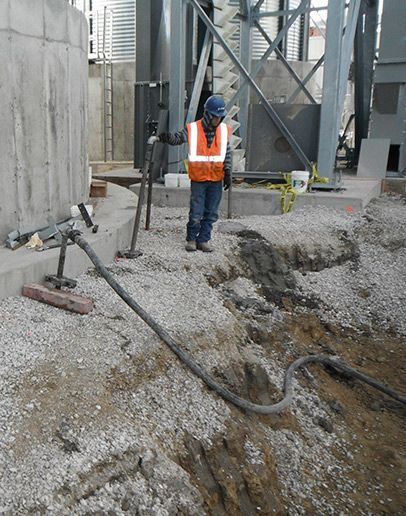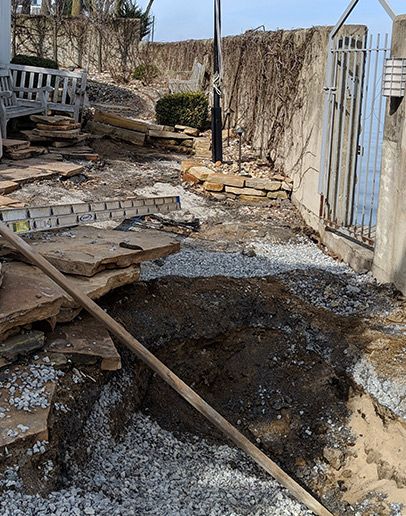Soil Stabilization
Includes:
- Soil Densification
- Underpinning
- Tunneling
- Excavations
- Shoreline Erosion Control
Soil Densification
Soil densification is a process used to densify weak soils and urban fill for structure and floor slab support, below-grade utility support, and site redevelopment.
Compaction grouting is the most often used grouting method to densify weak in-situ soils and urban fill. Soil densification is accomplished by injecting a cementitious or high-density polymeric grout into the ground to increase a soil’s density and load-bearing capacity. The carefully selected product is used to first displace and then densify weak soils. Slurry grouting is another method used to stabilize and increase the load-bearing capacity of weak soils and urban fill, typically for development purposes. Corrective methods and product selections are independently determined by site-specific conditions, evaluations, and soil analyses.
Applications for soil densification include, but are not limited to:
- Site Redevelopment
- Structure Support
- Pipeline Support
- Slab Support
- Roadway Support
- Many other above- and below-grade structures
Underpinning
Primarily there are two grouting methods used for underpinning a foundation when excavating in close proximity to an adjacent foundation: compaction grouting to densify soils, and permeation grouting to strengthen and immobilize granular soils.
Soil densification and permeation grouting are two of the most routinely-used grouting techniques to underpin a foundation for basement digouts or structure support. Neither process requires slab removal or excavation, providing cost-effective, minimally invasive, and long-term solutions.
When underpinning for the purpose of excavating in close proximity to a structure, certain precautions must be taken. In cohesive soils, a bench or one-to-one slope should be maintained or supplemental support with steel piers may be required. In granular soils, grout strengths can be adjustable from a few PSI to hundreds of PSI depending on loading, excavation requirements, and proximity to excavations.
Permeation grouting is particularly beneficial in sites where high water tables cause loose sands to run from under foundations or to be undermined during de-watering procedures. Permeation grouting immobilizes running sands and inhibits the lateral migration of water.
Tunneling
The most appropriate grouting method to create water cutoff and immobilize running soils during tunneling is permeation grouting. The grouting process strengthens soils, inhibits water migration, and prevents soil decompression.
Those conditions most problematic for tunneling operations are related to soil types and site conditions. Loose, weak soils and granular soils can decompress and run causing subsidence destabilizing of structures, utilities, and infrastructure above or adjacent to tunneling operations. De-watering can also cause soils to run and decompress as fine soil particles are removed.
Filling the open pore spaces between granular particles using permeation grouting increases the soil’s strength to inhibit soil decompression during tunneling operations, minimizing the potential affects to infrastructure.
Compensation grouting is a procedure performed to treat weak soils within and adjacent to a tunneling zone in advance and/or during tunneling operations. Soils can be pre-treated to increase their density to offset decompression if or when it may occur during tunneling.

Excavations
Permeation grouting to immobilize running sands is the most utilized soil retention grouting process to inhibit soil loss from beneath adjacent structures or below-grade utilities. It provides structure support and creates water cutoff during excavation.
Permeation grouting increases granular soil retention, soil shear strength, density, and also inhibits water migration through soils during excavation for short-term or long-term durations. Grouted soil masses are unaffected by freeze/thaw cycles or erosion and can be installed to treat permeable soil pathway lenses several feet in width or just a few inches. Grouting in advance of excavation operations can reduce or eliminate the need for de-watering and some shoring.
Shoreline Erosion Control
Permeation grouting is a soil stabilization process to immobilize running sands by creating monolithic soil masses unaffected by erosion or wave action.
Many fixed shoreline retention systems, whether riprap, tubular logs, or steel sheet pile, are affected to some greater or lesser degree by scouring action. Soil loss due to wave action, fluctuating water levels, and weather affects soil migration. Even structurally designed sheet pile systems are not immune to the effects of soil loss between sheet joints, around the edges, or from below shallow retention sheet pile walls.
This environmentally benign, long-term solution is minimally-invasive, performed without excavation, and provides structure support.


